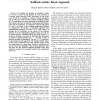Free Online Productivity Tools
i2Speak
i2Symbol
i2OCR
iTex2Img
iWeb2Print
iWeb2Shot
i2Type
iPdf2Split
iPdf2Merge
i2Bopomofo
i2Arabic
i2Style
i2Image
i2PDF
iLatex2Rtf
Sci2ools
115
Voted
CDC
2009
IEEE
2009
IEEE
Sensor selection for hypothesis testing in wireless sensor networks: a Kullback-Leibler based approach
We consider the problem of selecting a subset of p out of n sensors for the purpose of event detection, in a wireless sensor network (WSN). Occurrence or not of the event of interest is modeled as a binary Gaussian hypothesis test. In this case sensor selection consists of finding, among all n p combinations, the one maximizing the Kullback-Leibler (KL) distance between the induced p-dimensional distributions under the two hypotheses. An exhaustive search is impractical if n and p are large, as the resulting optimization problem is combinatorial. We propose a suboptimal approach with computational complexity of order O(n3 p). This consists of relaxing the 0/1 constraint on the entries of the selection matrices to let the optimization problem search over the set of Stiefel matrices. Although finding the Stiefel matrix is a nonconvex problem, we provide an algorithm that guarantees to produce a global optimum for p = 1, through a series of judicious problem reformulations. The case p >...
Related Content
| Added | 08 Nov 2010 |
| Updated | 08 Nov 2010 |
| Type | Conference |
| Year | 2009 |
| Where | CDC |
| Authors | Dragana Bajovic, Bruno Sinopoli, João Xavier |
Comments (0)

